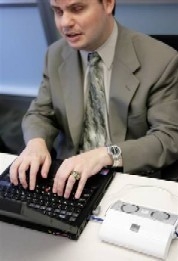
Technology for blind people has come a long way recently
Effectively dealing with blindness or extreme low vision have been among medical science’s greatest challenges for centuries. Many causes of blindness remain outside of the scope of medical cures or surgical correction. But new advances low vision eye aids and cutting-edge technology for the blind have brought new hope to those who live without seeing the world around them.
LVES offers hope to many
Some of the most exciting advances in new technology for the blind includes the Low Vision Enhancement System (LVES) currently being tested at Johns Hopkins University, The system, which uses three cameras imbedded in a goggle-like headset, captures and magnifies images in the standard visual range, including those typically labeled peripheral vision. The result is a complete wide-angle view of the surroundings at a magnification level that allows a near-normal level of information to be gathered from purely visual input.
Where a full visual enhancement system is not practical or even needed, a variety of low vision aids exist to help with everyday activities.
SARA systems
SARA, which stands for Scanning and Reading Appliance, is a device that allows the user to scan and hear a book, newspaper or other printed document. Many allow the user to control reading speed, and some even permit word-by-word or spelling options so the user can clarify any difficult passages.
~
Some SARA systems are large and require the user to bring the written material to the device, but new purse-sized portable units are making travel, visits to libraries and even menu use in restaurants easier for those facing visual challenges.
Portable desktop and handheld cameras for laptops
One of the most exciting devices to emerge in recent years is the handheld, multidirectional camera. This tiny palm-sized device connects to a user’s laptop to allow a user-controlled, magnified view of any object, printed document or other visual element to be seen on the laptop screen.
A user could browse the titles on a bookshelf, examine the details in a painting, look closely at a flower in the garden or clearly see the details of a loved one’s face. The small size and laptop capability means this view is not limited to a few locations or within a few feet of a desktop computer.
Voice recognition software
One of the most exciting business advances in technology for blind comes in the form of new and far better voice recognition software. New programs and highly sensitive sound equipment allows users to create business reports, e-mails or other printed documents with a greater degree of accuracy than the average typed document.
The new programs work from ordinary speech, with an accuracy rate of over 99%. Users no longer have to modify speech patterns to be understood; the newest programs capture ordinary conversational tones and rates. Playback features allow users to proof and correct content quickly and easily.
Other devices still make life easier
Many of the traditional “low tech” tools offer reliable assistance to those dealing with low vision issues. Items such as large-button telephones and keyboards, desktop magnifiers and talking clocks provide an affordable and effective option for making daily life easier and helping maintain independence.
While research into causes and cures for blindness continue, today’s technology is making it easier for the blind to enjoy a visually enhanced life.
